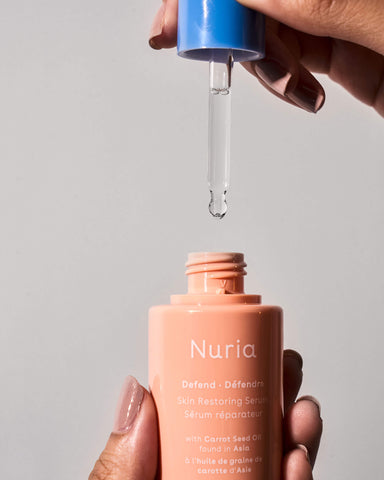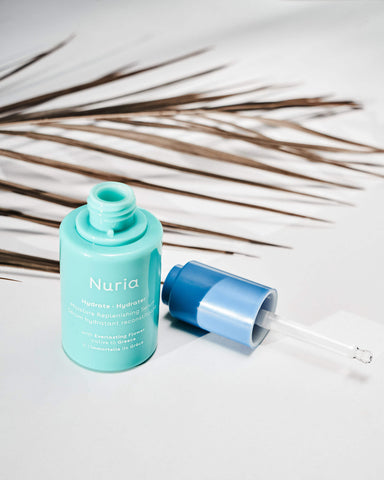
Alternative to Liquid Facelifts & Botox
In our youth-crazed culture, cosmetic injectables have become so common that for regulars, it’s as casual as ordering a drive-through latte on a lunch break. Got a line? Freeze it. Hollow cheeks? Plump them! We’re talking about Botox and dermal fillers (AKA the liquid facelift)! As the beauty industry continues evolving in its effort to replace cosmetic surgery, these in-office treatments have sealed their status as our new normal.
With more medi-spas towering our streets than new McDonald’s, it’s worth getting acquainted with today’s menu of injectables. Together, let’s unpack how Botox and fillers work and which at-home alternatives we can try instead.
What’s a liquid facelift?
The “magic” of the liquid facelift comes down to one main ingredient: hyaluronic acid. Yes, it’s that special! Capable of molding, plumping, and hydrating flat or sagging tissue, hyaluronic acid is the MVP of cosmetic injectables.
Hyaluronic acid: The injectable dermal filler
Like a sponge, hyaluronic acid is a sugar molecule that holds 1000 times its weight in water. Ergo, when we have this substance injected into our skin, it fuses with our natural tissue, soaking up water and saturating the area with plumpness, resilience, and elasticity.
This type of cosmetic treatment is called a dermal filler injection. The product being administered, known as dermal filler, is the liquid or pre-gel form of hyaluronic acid, which is mixed with lidocaine to numb pain. The injector can deliver the filler at varying levels of depth depending on what we’re trying to achieve: posteriorly (on the bone), intramuscularly (in the muscle), intradermally (into the dermis), or subcutaneously (in the fat layer right under the skin). At each layer, the filler takes on a specific look: when the product is deposited deeply, it mimics bone structure and offers a stronger lift, whereas the more superficial approach creates a cute-pudgy quality, mimicking the feel of fatty tissue.
Fillers can offer further customization in terms of how the substance is formulated. Available in a spectrum of thicknesses, they can range from soft and flexible versions for mobile areas like lips or nasolabial folds to denser versions for building the cheekbones or chin. Your cosmetic provider should be experienced in understanding the nature and movement patterns of these tissues, allowing them to choose the right types of fillers for specific zones of the face.
Dermal fillers versus Botox
If dermal fillers FILL, then think of Botox as a freezer, preventing muscles from contracting and wrinkling. But before we dive into those mechanics, let’s make something very clear: Botox is a brand name, not a type of cosmetic treatment. Botox belongs to a category of injectables called neuromodulators: products that paralyze the muscles.
There are a handful of other neuromodulator brands, but for simplicity’s sake, let’s just refer to this treatment as Botox. This drug is made from a toxin produced by a type of bacterium (Clostridium botulinum). When it’s injected into specific facial muscles, the area becomes paralyzed, creating a tightening and smoothing effect due to a lack of movement. That’s the key difference between fillers and Botox: the former infuses water into the skin for fullness, while the latter infuses a neurotoxin to weaken wrinkle-causing movements.
At-home alternative
With the rise of #cleanbeauty, people’s tastes are moving away from that overfilled look and toward natural alternatives to dermal fillers. Let’s learn about them!
The DIY option: sodium hyaluronate
As hyaluronic acid keeps dominating as a staple in the beauty world, more cosmetic brands are formulating products with this natural powerhouse. But unlike the injectable type of hyaluronic acid, the topical kind which we apply to our skin at home is slightly different, even though they’re still the same compound.
The topical version of hyaluronic acid (what we apply on top of our skin) is often a substance called sodium hyaluronate—a compound with the same chemical structure of hyaluronic acid but the molecules are chained together differently. And the point is…? The arrangement of these particles create a micro version of hyaluronic acid, allowing our pores to absorb it more effectively.
That’s the amazing thing about sodium hyaluronate: it’s thinner and more watery, so it can penetrate more deeply. Standard hyaluronic acid, on the other hand, has particles that are too large to enter the dermal layers—that’s why it needs to be injected.
Serums with sodium hyaluronate
As the demand for dewy skin rises, more hydrating serums are featuring sodium hyaluronate as the key ingredient. With its amazing ability to help the outer skin layer hold water, these molecules are THE must-have in clean beauty!
Nuria skin care is taking on a novel approach to this trend, combining the hydrating superpowers of sodium hyaluronate with the ancient tradition of Asian healing herbs. This clever cosmetic cocktail is what makes Nuria’s Defend Skin Restoring Serum so unique (and popular!). Alongside its water-rich benefits, the formula contains carob seed oil to defend skin from sun damage and rooibos, an antioxidant-rich plant that reduces fine lines and wrinkles.
Another option is Nuria’s Hydrate Moisture Replenishing Serum to promote softness, hydration, and brightness! It combines sodium hyaluronate (obviously!) with Everlasting Flower—an herb that stimulates that radiant, light-kissed sheen—along with Squalane, a moisturizer that mimics our natural oils.
While some surgeons swear the liquid facelift can’t replace surgery, many happy patients will share the opposite opinion. But like all things that seem “too good to be true,” it’s understandable why more people are second-guessing injectables. Ultimately, if our goal is to age gracefully and naturally, then having alternatives to the liquid facelift means we’ll never suffer from “Filler FOMO.”
About the author, Rachel Esco
Rachel Esco is freelance beauty copywriter based in Toronto, specializing in conscious cosmetics and natural skincare. Over her career, she’s collaborated on projects for leading global brands in skin care, hair care, makeup & nails. If stranded alone on a deserted island, she’d be content with the following two items: SPF and Netflix.


